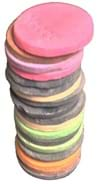Quick Look
Grade Level: Elementary school
Time Required: 1 hour
Expendable Cost: US $1.00
Group Size: 2
Subject Areas: Algebra, Earth and Space, Physical Science, Science and Technology
Introduction
Bolded words are vocabulary and concepts to highlight with students during the activity.
What is pressure? Pressure is defined as the amount of force applied per unit area or as the ratio of force to area (P = F/A). The pressure an object exerts can be calculated if its weight (the force of gravity on an object) and the contact surface area are known. For a given force (or weight), the pressure it applies increases as the contact area decreases. Engineers must understand air pressure because it affects the way in which air pollution travels through the air. Especially in highly populated areas, engineers work with local communities to understand their unique weather and atmospheric conditions, and suggest changes to keep the air quality at a safe level for breathing. They also create new prevention technologies that address air pollution at the source. 
Supplies
Each group needs:
- 2 sheets of graph paper
- 14 Necco™ wafers
- empty soda can
- 1 hardback book
- 1 digital scale (to be shared)
Subscribe
Get the inside scoop on all things TeachEngineering such as new site features, curriculum updates, video releases, and more by signing up for our newsletter!Procedure
Procedures Overview
Students develop an understanding of air pressure by using candy wafers to model altitude changes and by comparing its magnitude to gravitational force per unit area. Students also observe changes in pressure with an aluminum can experiment.
Pressure
- Divide the class into teams of two students each.
- Pass out the books, graph paper and soda cans to groups.
- Ask students to hold a book flat on their hands. Then, ask them to try to balance the side of the book on their palms. Ask them which way of holding the book seems to be heavier, or pushes more on their hands. (The side should seem heavier.)
- Have students, one group at a time, take their book and weigh it on the scale while laying flat. Then, have them turn it on its smallest side and weigh it. Ask students why the book weighs the same, but seems to push more on their hands when they are balancing it on its side. Explain to them that this is pressure (force per area).
- Instruct students to record the weight of their books on their graph paper.
- Students next calculate the pressure for the two configurations of the book. To do this, they outline the book on a sheet of graph paper in each configuration (flat and on its side).
- Then they calculate the area by counting the squares on the graph paper. Then they divide the weight of the book by the area, which gives them the pressure the book is exerting on the table/paper in pounds per square inch (psi). (Tip: It may help to provide an example on the board and/or help students with the division.)
- To understand this, students should see an example of how spreading weight decreases the pressure on an object. Have groups balance their book on top of an empty can. Then, have them carefully stand on the book, keeping their weight centered over the can (their teammates can help them balance by holding their hands). The empty can should support their weight.
- Now, have students remove the book and try to stand on the can—the can should crumple under this higher pressure (pressure that is not distributed).
Pressure and Altitude
- Ask students if/how they think air pressure changes with altitude. (Yes, it decreases as altitude increases.)
- Hand out Necco wafers to students and have each group make a stack of all their wafers. Explain that air pressure in Washington, DC (sea level) is ~14.7 psi, while in Denver, CO, it is ~12.4 psi. Use the wafers to demonstrate that the table under the bottom wafer (with 14 wafers on top), it is the equivalent of sea level.
- Have them point out where Denver would be in their model of the atmosphere (that is, in their stack of Necco wafers).
- Ask students to describe in their own words how air pressure changes with altitude. (The air pressure at sea level is the highest, because at that point all the air [wafers] is pressing on everything. So, as you go up in altitude, the air pressure is less.)
- Have students help clean up the wafers by eating them.
Wrap Up - Thought Questions
- What makes up the pressure we feel from the air? Why doesn't this pressure crush us?
- In terms of pressure, explain why sharp knives cut better then dull ones.
More Curriculum Like This

Students gain an understanding of air pressure by using candy or cookie wafers to model how it changes with altitude, comparing its magnitude to gravitational force per unit area, and observing its magnitude with an aluminum can crushing experiment. Worksheets provided.
Copyright
© 2013 by Regents of the University of ColoradoLast modified: May 12, 2022





User Comments & Tips